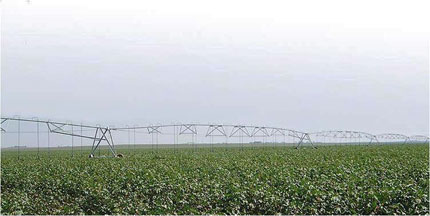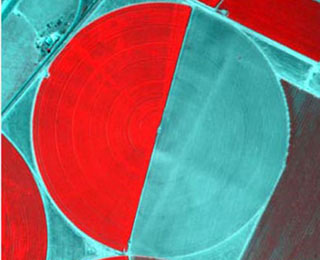As groundwater sources, such as the Ogallala Aquifer, dry up, growers have to make do with less and less irrigation water while still maximizing crop production. To address that problem, researchers from Texas Tech University and the USDA-Agricultural Research Service are asking a question that may seem counterintuitive – can farmers maximize cotton yield if they only irrigate part of their field? Surprisingly, the answer is yes.
 A center pivot-irrigated cotton field in Plainview, TX. Photo courtesy of Shyam Nair.
A center pivot-irrigated cotton field in Plainview, TX. Photo courtesy of Shyam Nair.
A research team, led by Shyam Nair of Texas Tech University, used the Cotton2K crop growth simulation model to estimate how cotton yield and profit would be affected by only irrigating certain percentages of a field. A database of 110 years of weather data from the region was used to run the simulation, and the results were published in the Jan.-Feb. issue of Agronomy Journal. The researchers found that irrigating 30 to 70 percent of a field, depending on the level of irrigation water available, produced the most yield and profit.
These results are possible because cotton can be grown both as an irrigated or non-irrigated crop if the rainfall is sufficient. A non-irrigated field will usually produce an adequate crop in three out of five years, says Nair.
“The yield of irrigated cotton is usually much greater than that for non-irrigated, but the management costs of non-irrigated cotton are very low,” explains Nair. “So a farmer can still make a profit growing non-irrigated cotton.”
Because cotton can grow without irrigation, Nair and co-authors, Stephan Maas, Chenggang Wang, and Steven Mauget, wondered what would happen if a low level of irrigation water was concentrated on a portion of a field while the rest was left to grow as non-irrigated crop. By using the water strategically in one area to reach a desired level of irrigation there, the researchers thought that perhaps yield would actually be better than if they distributed the limited amount of available water over the entire field.
“Crops are generally more responsive to irrigation when a desirable amount of irrigation water is available,” says Maas. “If we spread the water out to the entire field, the water may be very inadequate and can cause drastic yield reduction throughout the field.”
 A center-pivot field partitioned into two portions. Photo courtesy of Shyam Nair.
A center-pivot field partitioned into two portions. Photo courtesy of Shyam Nair.
Nair and his team found that irrigating only a part of the field did, in fact, maximize yields. The four levels of irrigation used in this study were 6, 9, 12, and 15 inches – modest values reflecting the potential water shortages that growers may face in the future. Maximum yields (combined yields from both irrigated and non-irrigated portions) were achieved when the irrigated portion received the equivalent of 20.5 inches of water. Therefore, the best yields were achieved by concentrating the chosen irrigation levels on just a portion of the field – 30, 45, 55 and 70 percent, respectively, under normal rainfall conditions. For each level of total irrigation, the maximum profit occurred at the same value of field partitioning as the maximum yield.
When faced with different rainfall conditions, however, the percentage of the field that should be irrigated changed. If there is little rainfall, irrigation will have to be concentrated on an even smaller portion of the field to provide the desired total water level. If the rainfall is high, however, the same amount of water can be spread over a larger area. For example, if rainfall is low, only 46 percent of a field should be irrigated at an irrigation level of 12 inches compared to 67 percent if rainfall is high.
The differences in yield and profit observed between low, medium, and high rainfall conditions suggest that farmers would benefit from accurate and reliable seasonal rainfall forecasts and could adapt their field partitioning strategies accordingly, Nair says. In the absence of those forecasts, farmers can follow a more conservative strategy and partition their fields into irrigated and non-irrigated portions based on long-term average rainfall conditions.
“In part, it depends on how big a gambler the producers are,” says Nair. “If they don’t want to take chances, they should manage the crop according to average conditions. If a forecast looks strong, and the producers are willing to take a chance, following a particular climatic scenario could result in additional profits.”
View the abstract at https://www.agronomy.org/publications/aj/abstracts/105/1/124

A research team, led by Shyam Nair of Texas Tech University, used the Cotton2K crop growth simulation model to estimate how cotton yield and profit would be affected by only irrigating certain percentages of a field. A database of 110 years of weather data from the region was used to run the simulation, and the results were published in the Jan.-Feb. issue of Agronomy Journal. The researchers found that irrigating 30 to 70 percent of a field, depending on the level of irrigation water available, produced the most yield and profit.
These results are possible because cotton can be grown both as an irrigated or non-irrigated crop if the rainfall is sufficient. A non-irrigated field will usually produce an adequate crop in three out of five years, says Nair.
“The yield of irrigated cotton is usually much greater than that for non-irrigated, but the management costs of non-irrigated cotton are very low,” explains Nair. “So a farmer can still make a profit growing non-irrigated cotton.”
Because cotton can grow without irrigation, Nair and co-authors, Stephan Maas, Chenggang Wang, and Steven Mauget, wondered what would happen if a low level of irrigation water was concentrated on a portion of a field while the rest was left to grow as non-irrigated crop. By using the water strategically in one area to reach a desired level of irrigation there, the researchers thought that perhaps yield would actually be better than if they distributed the limited amount of available water over the entire field.
“Crops are generally more responsive to irrigation when a desirable amount of irrigation water is available,” says Maas. “If we spread the water out to the entire field, the water may be very inadequate and can cause drastic yield reduction throughout the field.”

Nair and his team found that irrigating only a part of the field did, in fact, maximize yields. The four levels of irrigation used in this study were 6, 9, 12, and 15 inches – modest values reflecting the potential water shortages that growers may face in the future. Maximum yields (combined yields from both irrigated and non-irrigated portions) were achieved when the irrigated portion received the equivalent of 20.5 inches of water. Therefore, the best yields were achieved by concentrating the chosen irrigation levels on just a portion of the field – 30, 45, 55 and 70 percent, respectively, under normal rainfall conditions. For each level of total irrigation, the maximum profit occurred at the same value of field partitioning as the maximum yield.
When faced with different rainfall conditions, however, the percentage of the field that should be irrigated changed. If there is little rainfall, irrigation will have to be concentrated on an even smaller portion of the field to provide the desired total water level. If the rainfall is high, however, the same amount of water can be spread over a larger area. For example, if rainfall is low, only 46 percent of a field should be irrigated at an irrigation level of 12 inches compared to 67 percent if rainfall is high.
The differences in yield and profit observed between low, medium, and high rainfall conditions suggest that farmers would benefit from accurate and reliable seasonal rainfall forecasts and could adapt their field partitioning strategies accordingly, Nair says. In the absence of those forecasts, farmers can follow a more conservative strategy and partition their fields into irrigated and non-irrigated portions based on long-term average rainfall conditions.
“In part, it depends on how big a gambler the producers are,” says Nair. “If they don’t want to take chances, they should manage the crop according to average conditions. If a forecast looks strong, and the producers are willing to take a chance, following a particular climatic scenario could result in additional profits.”
View the abstract at https://www.agronomy.org/publications/aj/abstracts/105/1/124
Source:
No comments:
Post a Comment